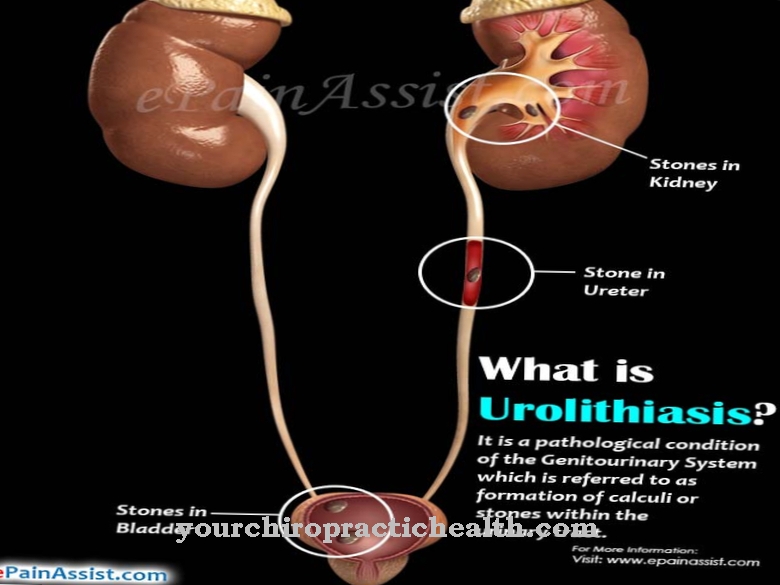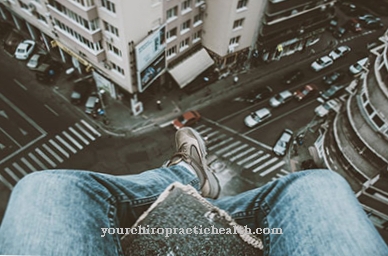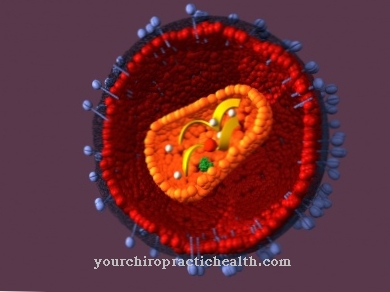Volvulus refers to the pathological twisting of a section of the intestine around its axis. It is therefore also commonly referred to as Intestinal obstruction designated. This twisting or twisting leads to an insufficient supply of blood in the affected section of the intestine. This can lead to an intestinal obstruction or death of the intestinal part (intestinal gangrene).
What is a volvulus?
If certain sections of the intestine are knotted or entwined with each other, it is a bowel entanglement. This condition can be life threatening. Entanglements of the intestine are often congenital, as the natural development of the intestine was then already disturbed in the womb.
The rotations required prenatally were then not performed or only incorrectly performed by the intestine. Parts of the intestine rotate around the stem. This carries the supplying or draining blood vessels. This change in position of the intestine can lead to a partial or complete occlusion of the intestinal tube. There are two main forms of bowel entanglement. Intussusception involves the invagination of one part of the intestine into another part of the intestine.
The invagination occurs along the side and causes blood congestion and swelling. It leads to intestinal obstruction. The second major form of bowel entanglement is axis rotation. A loop of intestine rotates up to 180 degrees, wraps around another loop and thus presses off the blood supply. The bowel can no longer fulfill its tasks due to a resulting intestinal obstruction. It can lead to an undersupply of vital organs and a life-threatening condition.
causes
A well-known cause of intestinal entanglement is malrotation, an incorrect rotation of the small and large intestines during prenatal development. Children are more likely to develop volvulus, and this is an emergency that needs to be treated immediately.
Infants in the first year of life are most often affected. Intestinal inflammation can also cause intestinal obstruction. Inflammation of the intestine occurs bacterially, chemically, through radiation, as an allergic reaction or as an immune reaction. Colon cancer can also be a causative disorder. Adhesions are also one of the causes of a volvulus.
These are cords of connective tissue between sections of the intestine that normally have no connection. The exact causes of these adhesions in the intestine are not known. It is suspected that it could be a reaction to a foreign body, a previous inflammation, or even to surgery. Operations themselves can also cause a bowel obstruction.
Symptoms, ailments & signs
A bowel obstruction is more common in babies and toddlers than in adults. Prenatal forms of the volvulus are also observed. Typical symptoms are constipation, colicky abdominal pain, gas, nausea and vomiting. Depending on the location of the entanglement, vomiting of bile and feces may occur.
Symptoms temporarily improve after vomiting. The symptoms often even disappear completely for a time. However, this is again followed by constipation, vomiting and bloody stools. A distinction can also be made between acute and chronic volvulus. With acute intestinal obstruction, the symptoms of vomiting, bloated upper abdomen and severe colicky abdominal pain appear suddenly.
In severe cases, shock or peritonitis often occurs. The chronically recurrent (recurring) volvulus is more characterized by non-specific abdominal pain and chronic constipation. Furthermore, the body is undersupplied with nutrients because their absorption in the intestine no longer works properly. The body becomes weaker and weaker due to malnutrition.
However, there can also be symptom-free intervals between the individual attacks. In severe cases, the interruption of blood flow often restricts the supply of the intestine to such an extent that the affected part of the intestine dies. Then the intestinal obstruction has developed into an intestinal obstruction. In this situation, there is a high risk of death through intestinal rupture and bacterial infection of the abdominal cavity (peritonitis). A bowel obstruction can usually only be treated surgically.
Diagnosis & course
The symptoms of a bowel obstruction are sudden, cramp-like abdominal pain, a distended upper abdomen, bilious-greenish vomiting and diarrhea-like, bloody stools. The upper abdomen is sensitive to pressure, while the lower abdomen is more sunken.
The diagnosis is difficult for the doctor. It is usually done after the symptoms you experience, a thorough physical exam, and imaging tests. Sometimes a correct diagnosis can only be made during surgery. Imaging examinations are X-rays and ultrasound.
In the case of an intestinal entanglement of the rear large intestine, the massive overinflation of the intestinal part can be seen on the X-ray image through a kind of coffee bean sign. The over-inflated part of the intestine then often has the contour of a coffee bean. The course of an intestinal entanglement is life-threatening as it leads to life-threatening intestinal obstruction and must therefore be treated as an emergency.
Complications
A volvulus can cause serious complications. An entanglement of the intestine initially causes severe abdominal pain, which increases in intensity as the disease progresses and significantly restricts the person concerned in everyday life. Major complications are to be expected if the entanglement leads to an undersupply of a section of the intestine.
Then it can lead to death of the intestinal part or to an intestinal obstruction. This is often accompanied by peritonitis, which later spreads to other internal organs and quickly develops into a life-threatening condition. If the volvulus is not treated immediately in intensive care, there is a risk of circulatory shock.
In the worst case, an intestinal obstruction can be fatal. Treatment is also fraught with dangers. Surgery always carries the risk of injuring parts of the intestine or causing an infection. Injuries to the intestinal walls can lead to functional disorders that may persist permanently.
Sometimes an artificial anus must be placed, which is associated with the risk of hernias and injuries. Finally, the administration of medication can lead to side effects and interactions.
When should you go to the doctor?
In the case of abdominal pain, abdominal irregularities, nausea or vomiting, the cause of the symptoms should be clarified. If after a short time there is already a clear relief of the disturbances, this is often a short-term health impairment. A doctor is not required if there is permanent freedom from symptoms. If the symptoms reappear, if they last for a long time or if they are characterized by an increasing character, a doctor must be consulted. There is a need for action, particularly in the case of a chronic course of the disease, as an intestinal entanglement can lead to serious health developments.
Flatulence, constipation, or a strong feeling of pressure in the abdomen indicate irregularities that should be investigated. If blood can be seen from the anus when using the toilet or if there are sudden health problems, a doctor should be consulted as soon as possible. If the intestine is entangled, there is a potential risk to your own life.
For this reason, rapid and unexpected loss of health in particular should be discussed with a doctor. Mobility disorders, hypersensitivity to pressure in the stomach or intestines and sweating are warning signals for the human organism. Sudden changes in the circulatory system, irritability or a rapid decline in physical performance should be examined and treated.
Treatment & Therapy
To treat a bowel entanglement, it is necessary to return the relevant section of the bowel to its original position as quickly as possible. This can only be done with an operation. Time is of the essence in such operations, as the cut off blood supply to the affected section of the intestine quickly leads to tissue death.
The turned-back part of the intestine is fastened during the operation to prevent repeated twisting. If the affected part of the intestine is already so damaged that a restoration of the function is no longer to be expected, parts of the damaged tissue are removed. Under certain circumstances it may be necessary that an enterostomy (artificial anus) has to be placed.
In a more conservative approach, the volvulus is first acutely decompressed. A flexible colonoscope is used.It is important to determine whether the intestine is still vital or not. If the intestine is still vital, an examination of the anal canal is carried out as a first measure. After the examination, an intestinal tube is placed. A reduction in the volvulus is then indicated by a noisy discharge of gas and stool. The type of therapy always depends on how badly the blood flow to the intestine or the affected section of the intestine is impaired.
prevention
Sensible bowel obstruction prevention means maintaining good bowel health. This includes a healthy diet with valuable fiber, lots of fruit and vegetables. The acid-base balance should be balanced.
It is also important for the intestine to supply sufficient fluid - preferably water or drinks with low sugar levels. Food that is difficult to digest should be avoided. Regular exercise is also important for a healthy bowel.
Aftercare
If the intestinal obstruction (volvulus) has been treated, no medical follow-up is required. After the recovery phase, the patient is ready for action. The duration of the recovery phase depends on the age of the person affected. Exercise is important during recovery, but not physical exertion. Changing your diet lowers the risk of getting sick again.
Sufficient fiber combined with vitamins and minerals keep the intestines healthy. The daily fluid intake in sufficient quantity supports the bowel function. Eating too quickly is unhealthy. Several smaller servings spread over the day are recommended. Don't forget to exercise daily.
During the operation, part of the intestine had to be removed. An artificial anus was necessary. This enterostoma is removed after a while. Regeneration after the first part of the operation takes longer. Medical follow-up includes dealing with the stoma.
The medical staff cleans the access daily. After a few days, the patient takes over these actions. The intestine has regenerated and the artificial outlet is removed. After the wound has healed, no further medical measures are necessary. The change in diet is also required here. The necessary steps are already explained by the nursing staff in the "stoma phase".
You can do that yourself
An acute volvulus requires immediate medical attention. In the event of stomach pain, malaise or other signs of intestinal obstruction, the emergency services should be alerted. The body should be rested until the doctor arrives.
An acute volvulus must be treated surgically in order to prevent the affected section of the intestine from dying off. After the procedure, the main thing to do is to rest and take care of yourself. If necessary, the diet must be changed. In the case of a chronic volvulus, an operative procedure is also necessary. The patient must then adhere to the medical guidelines and avoid sporting activity, for example. If there is a volvulus of the sigmoid, medical intervention is indicated. Afterwards, rest easy and a change in lifestyle.
In addition to regular physiotherapy, which the sick can do at home, enough fruit and vegetables should be consumed. The menu should also consist of high-fiber foods that are also easy to digest. A nutritionist can create a suitable plan. It is important to drink enough fluids. Water and isotonic drinks have proven particularly useful. Physical activity is also important for the health of the gastrointestinal tract.


.jpg)




















.jpg)



